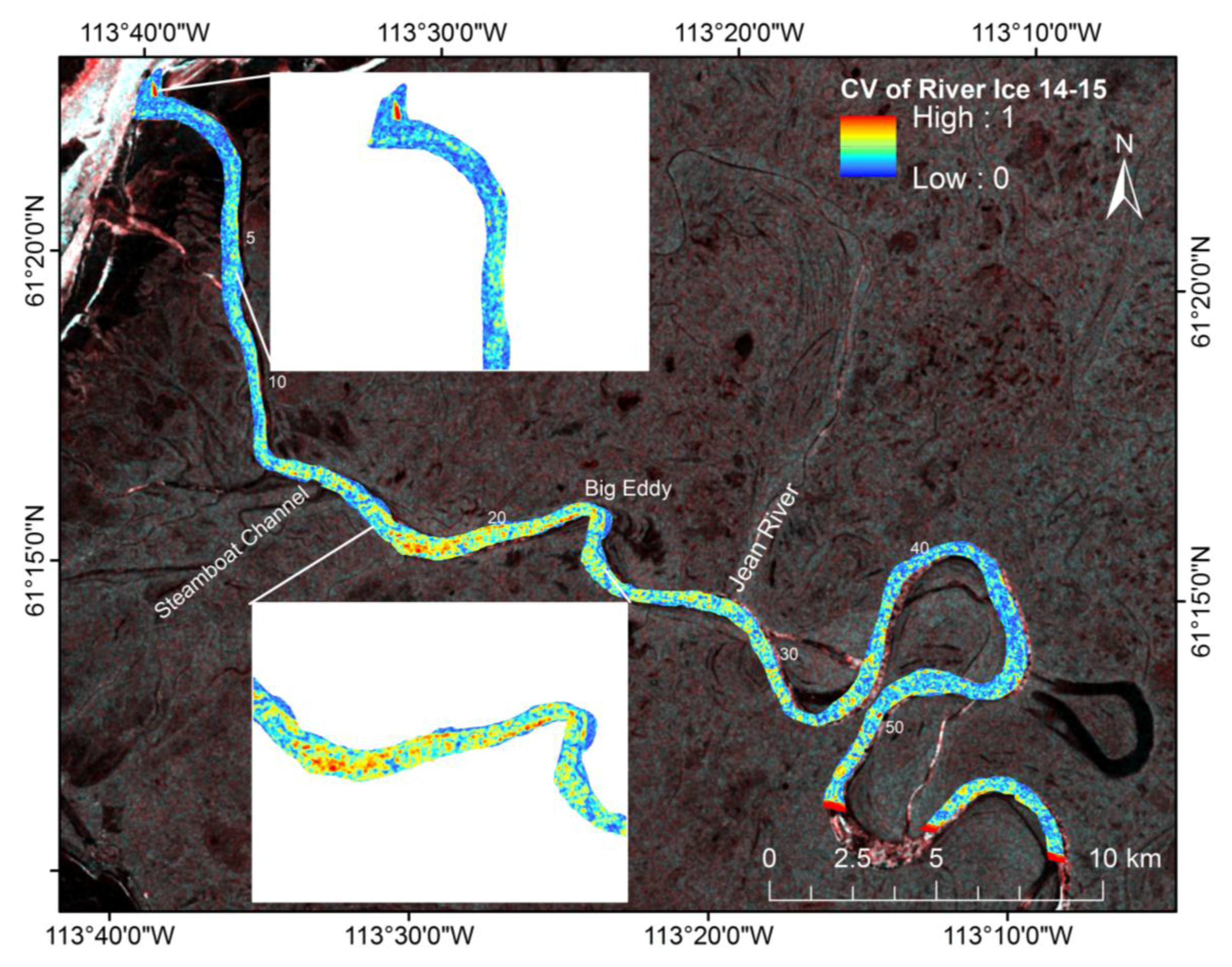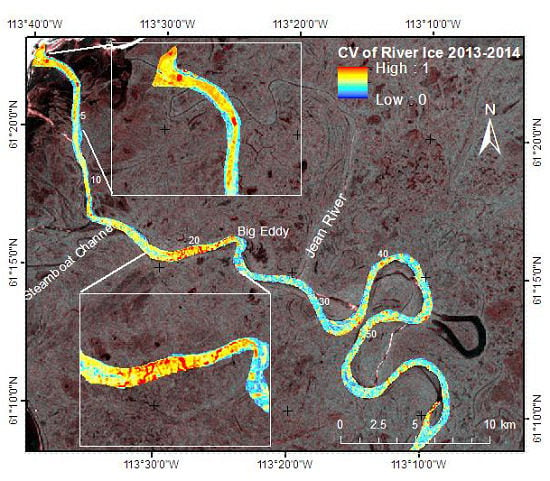Monitoring the Variation in Ice-Cover Characteristics of the Slave River, Canada Using RADARSAT-2 Data—A Case Study
Abstract
:1. Introduction
2. Material and Methods
2.1. Study Area

2.2. Space-Borne Radar Data and River Ice Monitoring
| ID | Acquired Date | Polarization | Beam Mode | Incidence Angle | Study Purpose |
|---|---|---|---|---|---|
| 1 | 21 November 2013 | HH+HV | FOW3 | 38.7–45.3 | To classify ice cover types and analyze ice cover variation during winter 2014 |
| 2 | 15 December 2013 | HH+HV | FOW3 | 38.7–45.3 | |
| 3 | 8 January 2014 | HH+HV | FOW3 | 38.7–45.3 | |
| 4 | 1 February 2014 | HH+HV | FOW3 | 38.7–45.3 | |
| 5 | 25 February 2014 | HH+HV | FOW3 | 38.7–45.3 | |
| 6 | 10 December 2014 | HH+HV | FOW3 | 38.7–45.3 | To classify ice-cover types during winter 2015 and compare with winter 2014 |
| 7 | 3 January 2015 | HH+HV | FOW3 | 38.7–45.3 | |
| 8 | 19 December 2014 | HH+HV+VH+VV | FQ17W | 35.7–38.6 | To analyze ice cover variation during winter 2015 and compare with the variation in winter 2014 |
| 9 | 12 January 2015 | HH+HV+VH+VV | FQ17W | 35.7–38.6 | |
| 10 | 5 February 2015 | HH+HV+VH+VV | FQ17W | 35.7–38.6 | |
| 11 | 1 March 2015 | HH+HV+VH+VV | FQ17W | 35.7–38.6 |
2.3. Characteristics of the Slave River Freeze-Up



2.4. Radar Backscatter Based River Ice Variation
2.5. Mapping Algorithm of River Ice Types


2.6. Validation
3. Results and Discussion
3.1. Spatio-Temporal Variation of the Ice Cover along the Slave River Delta Channel
3.1.1. Intra-Annual Variation of the Ice Cover


3.1.2. Inter-Annual Variation of the Ice Cover


3.2. Monitoring Ice Cover Types and Freeze-Up Progression during Winter 2013–2014






3.3. Monitoring the Ice Cover during Winter 2014–2015



4. Conclusions
Acknowledgments
Author Contributions
Conflicts of Interest
References
- Morse, B.; Hicks, F. Advances in river ice hydrology 1999–2003. Hydrol. Process. 2005, 19, 247–263. [Google Scholar] [CrossRef]
- Lindenschmidt, K.-E.; Maurice, S.; Rick, C.; Robert, H. Ice jam modelling of the Lower Red River. J. Water Resour. Prot. 2012, 2012, 1–11. [Google Scholar] [CrossRef]
- Jeffries, M.O.; Morris, K.; Duguay, C.R. Floating Ice: Lake Ice and River Ice. Available online: http://www.researchgate.net/profile/Claude_Duguay/publication/236173528_Floating_ice_lake_ice_and_river_ice/links/0046352c47d2ad71d3000000.pdf (accessed on 17 June 2015).
- Hicks, F. An overview of river ice problems: CRIPE07 guest editorial. Cold Reg. Sci. Technol. 2009, 55, 175–185. [Google Scholar] [CrossRef]
- Shen, H.T. A trip through the life of river ice-research progress and needs. In Proceedings of the 18th IAHR International Symposium on Ice, Sapporo, Japan, 28 August–1 September 2006.
- Das, A.; Sagin, J.; van der Sanden, J.; Evans, E.; McKay, H.; Lindenschmidt, K.-E. Monitoring the freeze-up and ice cover progression of the Slave River. Can. J. Civil Eng. 2015, 42, 1–13. [Google Scholar] [CrossRef]
- Jasek, M.; Gauthier, Y.; Poulin, J.; Bernier, M. Monitoring of freeze-up on the Peace River at the Vermilion Rapids using RADARSAT-2 SAR data. In Proceedings of the 17th Workshop on River Ice, CGU HS Committee on River Ice Processes and the Environment, Edmonton, AB, Canada, 21–24 July 2013.
- Lindenschmidt, K.-E.; van der Sanden, J.J.; Demski, A.; Drouin, H.; Geldsetzer, T. Characterising river ice along the Lower Red River using RADARSAT-2 imagery. In Proceedings of the 16th Workshop on River Ice, Winnipeg, MB, Canada, 18–22 September 2011; pp. 198–213.
- Coburn, C.; Roberts, A. A multiscale texture analysis procedure for improved forest stand classification. Int. J. Remote Sens. 2004, 25, 4287–4308. [Google Scholar] [CrossRef]
- Weber, F.; Nixon, D.; Hurley, J. Semi-automated classification of river ice types on the Peace River using RADARSAT-1 Synthetic Aperture Radar (SAR) imagery. Can. J. Civil Eng. 2003, 30, 11–27. [Google Scholar] [CrossRef]
- Gauthier, Y.; Weber, F.; Savary, S.; Jasek, M.; Paquet, L.-M.; Bernier, M. A combined classification scheme to characterise river ice from SAR data. EARSeL eProc. 2006, 5, 77–88. [Google Scholar]
- Drouin, H.; Gauthier, Y.; Bernier, M.; Jasek, M.; Penner, O.; Weber, F. Quantitative validation of RADARSAT river ice maps. In Proceedings of the 14th Workshop on River Ice, Québec City, QC, Canada, 19–22 June 2007.
- Unterschultz, K.; van der Sanden, J.; Hicks, F. Potential of RADARSAT-1 for the monitoring of river ice: Results of a case study on the Athabasca River at Fort McMurray, Canada. Cold Reg. Sci. Technol. 2009, 55, 238–248. [Google Scholar] [CrossRef]
- Van der Sanden, J.J.; Drouin, H.; Hicks, F.E.; Beltaos, S. Potential of RADARSAT-2 for the monitoring of river freeze-up processes. In Proceedings of the 15th Workshop on River Ice, St. John’s, NL, Canada, 15–17 June 2009; pp. 179–197.
- Van der Sanden, J.J.; Drouin, H. Satellite SAR observations of river ice cover: A RADARSAT-2 (C-band) and ALOS PALSAR (L-Band) comparison. In Proceedings of the 16th Workshop on River Ice, Canadian Geophysical Union–Hydrology Section, Committee on River Ice Processes and the Environment, Winnipeg, MB, Canada, 18–22 September 2011; pp. 179–197.
- Gauthier, Y.; Tremblay, M.; Bernier, M.; Furgal, C. Adaptation of a radar-based river ice mapping technology to the Nunavik context. Can. J. Remote Sens. 2010, 36, S168–S185. [Google Scholar] [CrossRef]
- Mermoz, S.; Allain, S.; Bernier, M.; Pottier, E.; Gherboudj, I. Classification of river ice using polarimetric SAR data. Can. J. Remote Sens. 2009, 35, 460–473. [Google Scholar] [CrossRef]
- Lindenschmidt, K.-E.; Syrenne, G.; Harrison, R. Measuring ice thicknesses along the Red River in Canada using RADARSAT-2 satellite imagery. J. Water Res. Prot. 2010, 2, 923–933. [Google Scholar] [CrossRef]
- Lindenschmidt, K.-E.; Chun, K.P. Geospatial modelling to determine the behaviour of ice cover formation during freeze-up of the Dauphin River in Manitoba. Hydrol. Res. 2014, 45, 645–659. [Google Scholar] [CrossRef]
- Lindenschmidt, K.-E.; Das, A. A geospatial model to determine patterns of ice cover breakup along the Slave River. Can. J. Civil Eng. 2015, 42, 1–11. [Google Scholar] [CrossRef]
- PWGSC. Slave River: Water and Suspended Sediment Quality in the Transbounday Reach of the Slave River, Northwest Territories; Public Works and Government Services of Canada (PWGSC): Gatineau, QC, Canada, 2013. [Google Scholar]
- Nghiem, S.V.; Leshkevich, G.A. Satellite SAR remote sensing of Great Lakes ice cover, Part 1. Ice backscatter signatures at C band. J. Great Lakes Res. 2007, 33, 722–735. [Google Scholar] [CrossRef]
- Hallikainen, M.; Winebrenner, D.P. The physical basis for sea ice remote sensing. In Microwave Remote Sensing of Sea Ice; AGU: Washington, DC, USA, 1992; pp. 29–46. [Google Scholar]
- Matzler, C.; Wegmuller, U. Dielectric properties of freshwater ice at microwave frequencies. J. Phys. D 1987, 20, 1623. [Google Scholar] [CrossRef]
- Evans, S. Dielectric properties of ice and snow—A review. J. Glaciol. 1965, 5, 773–792. [Google Scholar]
- Hallikainen, M. Review of the microwave dielectric and extinction properties of sea ice and snow. In Proceeding of the IEEE IGARSS, Houston, TX, USA, 26–29 May 1992; pp. 961–965.
- MDA. RADARSAT-2 Product Description. Available online: http://gs.mdacorporation.com/products/sensor/radarsat2/RS2_Product_Description.pdf (accessed on 17 June 2015).
- Mansourpour, M.; Rajabi, M.; Blais, J. Effects and performance of speckle noise reduction filters on active radar and SAR Images. In In Proceeding of the ISPRS Ankara Workshop, Ankara, Turkey, 14–16 February 2006; pp. 14–16.
- Abdi, H. Coefficient of variation. In Encyclopedia of Research Design; Salkind, N.J., Ed.; SAGE Publications, Inc.: Thousand Oaks, CA, USA, 2010; pp. 169–171. [Google Scholar]
- Mudelsee, M. Climate Time Series Analysis: Classifical Statistical and Bootstrap Methods; Springer: New York, NY, USA, 2010. [Google Scholar]
- Soh, L.-K.; Tsatsoulis, C. Texture analysis of SAR sea ice imagery using gray level co-occurrence matrices. IEEE Trans. Geosci. Remote Sens. 1999, 37, 780–795. [Google Scholar] [CrossRef]
- Dehariya, V.K.; Shrivastava, S.K.; Jain, R. Clustering of image data set using K-means and fuzzy K-means algorithms. In Proceedings of the 2010 International Conference on Computational Intelligence and Communication Networks (CICN), Bhopal, India, 26–28 November 2010.
- Sulaiman, S.N.; Isa, N.A.M. Adaptive fuzzy-K-means clustering algorithm for image segmentation. IEEE Trans. Consumer Electron. 2010, 56, 2661–2668. [Google Scholar] [CrossRef]
- Jain, A.K. Data clustering: 50 years beyond K-means. Pattern Recognit. Lett. 2010, 31, 651–666. [Google Scholar] [CrossRef]
- Ripley, B. Classification and Regression Trees. R Package Version 1.0–27. Available online: http://CRAN.R-project.org/package=tree (accessed on 17 June 2015).
- Arkett, M.; Flett, D.; de Abreu, R. C-band multiple polarization SAR for ice monitoring–What can it do for the Canadian ice service. In Proceedings of Envisat Symposium, Montreux, Switzerland, 23–27 April 2007.
- Komarov, A.S.; Barber, D.G. Sea ice motion tracking from sequential dual-polarization RADARSAT-2 images. IEEE Trans. Geosci. Remote Sens. 2014, 52, 121–136. [Google Scholar] [CrossRef]
- Vachon, P.W.; Wolfe, J. C-band cross-polarization wind speed retrieval. IEEE Geosci. Remote Sens. Lett. 2011, 8, 456–459. [Google Scholar] [CrossRef]
- Jefferies, B. Radarsat-2—New Ice Information Products. In Proceedings of the 13th Meeting—International Ice Charting Working Group, Tromso, Norway, 15–19 October 2012.
- Zhang, B.; Perrie, W.; Li, X.; Pichel, W.G. Mapping sea surface oil slicks using RADARSAT-2 quad-polarization SAR image. Geophys. Res. Lett. 2011, 38. [Google Scholar] [CrossRef]
© 2015 by the authors; licensee MDPI, Basel, Switzerland. This article is an open access article distributed under the terms and conditions of the Creative Commons Attribution license (http://creativecommons.org/licenses/by/4.0/).
Share and Cite
Chu, T.; Das, A.; Lindenschmidt, K.-E. Monitoring the Variation in Ice-Cover Characteristics of the Slave River, Canada Using RADARSAT-2 Data—A Case Study. Remote Sens. 2015, 7, 13664-13691. https://doi.org/10.3390/rs71013664
Chu T, Das A, Lindenschmidt K-E. Monitoring the Variation in Ice-Cover Characteristics of the Slave River, Canada Using RADARSAT-2 Data—A Case Study. Remote Sensing. 2015; 7(10):13664-13691. https://doi.org/10.3390/rs71013664
Chicago/Turabian StyleChu, Thuan, Apurba Das, and Karl-Erich Lindenschmidt. 2015. "Monitoring the Variation in Ice-Cover Characteristics of the Slave River, Canada Using RADARSAT-2 Data—A Case Study" Remote Sensing 7, no. 10: 13664-13691. https://doi.org/10.3390/rs71013664
APA StyleChu, T., Das, A., & Lindenschmidt, K.-E. (2015). Monitoring the Variation in Ice-Cover Characteristics of the Slave River, Canada Using RADARSAT-2 Data—A Case Study. Remote Sensing, 7(10), 13664-13691. https://doi.org/10.3390/rs71013664








